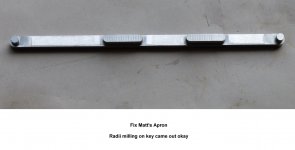stoneaxe
Stainless
- Joined
- Mar 2, 2010
- Location
- pacific northwest
I could use some rotary table setup help here-
How is the work positioned on the rotary table? For example- say there is a 1" wide x 6" long bar that has to have a radius put on the end.
How do I measure to ensure the bar long axis is centered on the radial axis of the rotary table? There is no parallel surface on the table to measure to.
The only way I can think of is to find the center point of the rotary table at the pivot, subtract 1/2 the stock width, and then run the mill table in and out to get the same measurement at both ends of the stock.
Thanks for any tips!
How is the work positioned on the rotary table? For example- say there is a 1" wide x 6" long bar that has to have a radius put on the end.
How do I measure to ensure the bar long axis is centered on the radial axis of the rotary table? There is no parallel surface on the table to measure to.
The only way I can think of is to find the center point of the rotary table at the pivot, subtract 1/2 the stock width, and then run the mill table in and out to get the same measurement at both ends of the stock.
Thanks for any tips!




 Thanks.
Thanks.